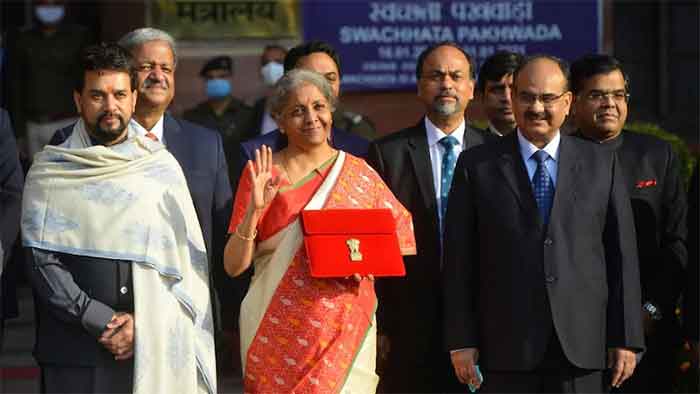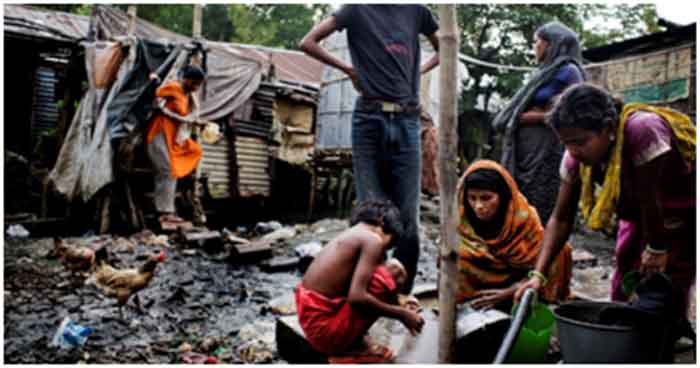
Despite all the manipulations done by the Modi Government with the GDP figures, the economic slowdown has been so persistent that now, finally, the official figures also admit that economy began slowing down before the pandemic.
- GDP Growth Rate
Till 2019, just before the elections, Modi and the then Finance Minister Arun Jaitley claimed that India is the fastest growing major economy in the world. Even during her Budget speech of 2020, Finance Minister Nirmala Sitharaman claimed that the annual average GDP growth during last five years (that is, first term of Modi) was higher than the growth achieved by any government since independence.
The PM and his cabinet are adroit manipulators and liars. The FM made these claims on the basis of repeated and deliberate manipulation of GDP figures. This process began a year after Modi came to power, when the Central Statistical Organisation (CSO, the government agency responsible for co-ordination of statistical activities in India) revised the methodology for calculating GDP and magically upped the GDP growth rate by 2 percentage points, making India the world’s fastest major economy. After that, as we have shown in an article published in Janata Weekly,[1] the CSO repeatedly played around with GDP figures right up to 2019, to make it appear that the GDP growth rate during Modi’s first four years was higher than the growth rate achieved during the previous UPA government.
This manipulation has also been admitted by Arvind Subramanian, who was the Modi Government’s Chief Economic Advisor from 2014 to 2018. Of course, he stayed silent while in power. After submitting his resignation, wisdom dawned, and in a working paper published in June 2019, he stated that India’s GDP was overestimated by 2.5 percentage points, and that India’s economy may have grown at an average of 4.5 per cent in the period between 2011-12 and 2016-17, as against the official figures of 6.9 per cent.[2]
So, it is obvious that all the claims of the Modi Government that the economy is moving towards becoming a 5 trillion dollar economy is all bunkum. What indeed is the true GDP of the country is difficult to say.
Despite all these machinations, the slowdown simply won’t go away. The slowdown has been so persistent and deep that after 2018, the CSO too has been forced to admit it. Now, finally, the official figures admit the economy has been slowing for the last 4 years (Table 1).
Table 1: India, GDP Growth Rate, 2017–20 (%)
| 2016-17 | 2017-18 | 2018-19 | 2019-20 | |
| GDP Growth Rate
(at 2011-12 prices) |
8.3 | 6.8 | 6.5 | 4.0 |
Soon after the FM claimed in her budget speech of 2020 that the economy had clocked a growth rate of 7.4% on the average for the five year period 2014-19, the CSO released figures that showed the GDP growth rate slowed down to 3.1% for January-March 2020 (Table 2), and the growth rate for 2019-20 had fallen to 4.0%, an 11-year low.
Table 2: Quarterly GDP Growth Rate, 2018-19 and 2019-20 (%)
| 2018-19 | 2019-20 | 2020-21 | ||||||||
| Q1 | Q2 | Q3 | Q4 | Q1 | Q2 | Q3 | Q4 | Q1 | Q2 | |
| GDP Growth Rate
(at 2011-12 prices) |
7.1 | 6.2 | 5.6 | 5.7 | 5.2 | 4.4 | 4.1 | 3.1 | -23.9 | -7.5 |
This means that the economy had begun sinking into recession even before the corona pandemic hit the economy. It is not the pandemic that is responsible for the current economic slowdown; the pandemic has only worsened it.
Subsequently, the CSO has released figures showing that the economy has suffered an unprecedented crash in the first two quarters of FY21 (Table 2).
There is a limit to how much you can lie! And so the FM’s budget speech this year is silent on GDP growth rate.
- Real Growth Rate Close to Zero
Actually, this growth rate is also much exaggerated, as this GDP growth rate is based on data available for the organised sector only. It does not include data for the unorganised sector, except for agriculture – for which data is available. For the remaining unorganised sector, data is collected once in five years and in between it is assumed that the organised sector can be used to proxy the unorganised sector also.
Under normal circumstances, this is okay, but during the past few years, especially after demonetisation and GST, which adversely affected the unorganised sector much more than the organised sector, this extrapolation is no longer valid. This has become more so during the lockdown, which totally shut down the unorganised sector.
So, the rate of growth of –23.9% as estimated by the CSO is largely the rate of decline of the organised sector.
The unorganised sector is 94% of employment and 45% of the output of the economy. So, it is huge. If the organised sector declined by the official figure of 23.9%, the unorganised sector would have declined by around 70–80% during the first quarter (Q1) of 2020-21.
If we take this into account, then actual GDP growth rate of the economy for Q1 of FY 2020-21 would not be –23.9%, but probably close to –45%.[3]
- Slight Recovery in Q2 May be Shortlived
As the above mentioned figures for GDP growth rate for Q1 and Q2, 2020-21, show, there has been some recovery from the deep abyss into the which the economy had fallen in Q1 due to the total lockdown. This is being celebrated by mainstream economists as indicating that the economy is on its way to recovery.
But this marginal recovery is not because of any virture of the government. The government has done nothing to stimulate the recovery. The FM is lying when she claims in her budget speech that “Total financial impact of all AtmaNirbhar Bharat packages including measures taken by RBI was estimated to about Rs 27.1 lakh crore which amounts to more than 13% of GDP.” As we have discussed extensively in articles published earlier in Janata Weekly, the government even in its relief package had merely indulged in jugglery of numbers; the actual relief package was less than Rs 2 lakh crore. The slight recovery that has taken place during Q2 of this financial year is basically because the government gradually started lifting the lockdown from June onwards.
Because of this, while the economy, not surprisingly, is climbing out of the abyss, how far it will climb depends on the nature of the climb itself. This will require a closer look at the factors that have led to this recovery.
An examination of the various components of the GDP shows that this recovery is not based on any significant recovery in the condition of the people. The GDP data show that while the second quarter GDP was less than that of the previous year by 7.5%, private consumption expenditure in real terms was less by even more, 11.32%. This is also reflected in the fact that the share of private consumption expenditure in GDP has declined between the second quarters of 2019-20 and 2020-21 – it was 56.5% in Q2 2019-20, and fell to 54.2% in Q2 of 2020-21 (Table 3).
Even more disturbingly, if we take the entire first half of 2020-21, then there is an almost 20 per cent drop in real private consumption expenditure compared to last year (Table 3).
Table 3: Private Final Consumption Expenditure, Q2 and HI, FY 2020 and 2021
| 2019-20 Q2 (1) | 2020-21 Q2 (2) | % Change: 2 over 1 | |
| Private Final Consumption Expenditure (at 2020-21 prices) | 2,025,488 | 1,796,290 | –11.32% |
| Share in GDP | 56.5% | 54.2% | |
| 2019-20
Apr-Sept (1) |
2020-21
Apr-Sept (2) |
% Change: 2 over 1 | |
| Private Final Consumption Expenditure (at 2020-21 prices) | 4,018,455 | 3,257,453 | –19% |
The consumption of the better-off sections of the population must have got back to pre-pandemic levels once the lockdown had been eased. This means that the consumption of the working people must have fallen even more than 19% during the first half of 2020-21 over the previous year.
So, the recovery has not been accompanied by a recovery in the per capita consumption of the working people. Then how has the recovery taken place? As can be seen from the data about the components of GDP (we’re not discussing it here for lack of space), the recovery has basically taken place due to an increase in private investment. But private investment cannot really continue to increase for long, unless domestic consumption picks up. And that has fallen hugely during the first half of FY 2021.[4]
Domestic consumption can only pick up if the government takes steps to put purchasing power in the hands of people – and that it has not been willing to do, as is obvious from the stinginess of its relief package.
Has the Budget 2021 done anything to reverse this trend, and stimulate recovery? That we see in the subsequent parts of this essay.
References
- Neeraj Jain, “Modinomics = Falsonomics, Part I”, Janata Weekly, 13 April 2019 (available online).
- “India’s GDP growth overestimated by 2.5%, says former CEA Arvind Subramanian”, 11 June 2019, https://www.thehindubusinessline.com.
- Arun Kumar, “What the 23.9% Drop in Q1 GDP Tells – and Doesn’t Tell – Us About the Economy”, 2 September 2020, https://thewire.in.
- For more on this, see: Prabhat Patnaik, “What the Second Quarter GDP Estimates Reveal’, 7 December 2020, https://www.networkideas.org.
Neeraj Jain is a Btech in Electrical Engineering. He is a social activist with an activist group called Lokayat in Pune, and is also the Associate Editor of Janata Weekly, a weekly print magazine and blog published from Mumbai. This article was earlier published in Janata. Email: [email protected]
GET COUNTERCURRENTS DAILY NEWSLETTER STRAIGHT TO YOUR INBOX












































